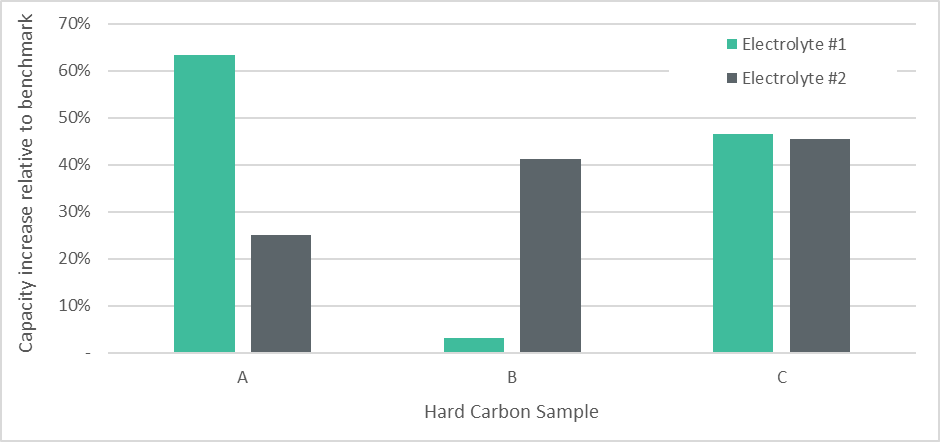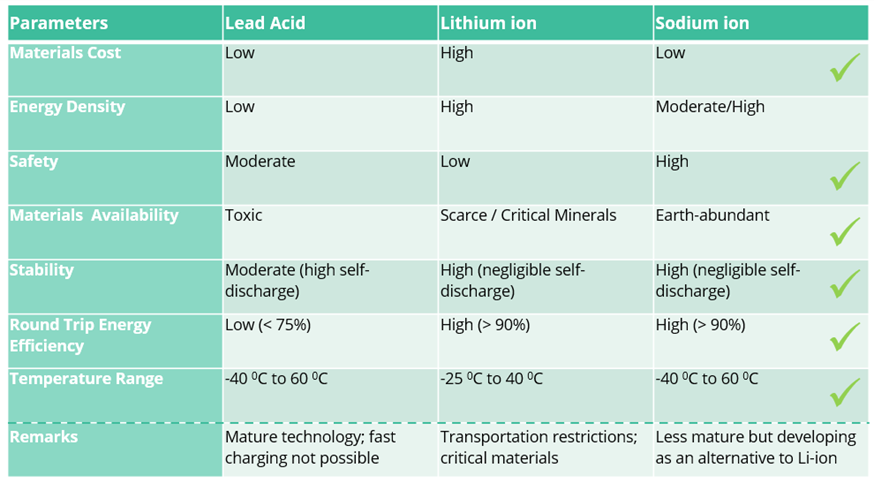
HIGHLIGHTS
- Additional testing benchmarked against commercial hard carbon materials completed showing up to 63% improvement in reversible capacities
- Reproducibility across alternative bio-waste feedstock sources demonstrated
- Acceleration of R&D planned and techno-economic analysis underway
Sparc Technologies Limited (ASX: SPN) (Sparc or the Company) is pleased to provide an update on its project with Queensland University of Technology (QUT) targeting development of sustainably sourced hard carbon anode material for sodium ion batteries (SIBs).
QUT has delivered a second project milestone report which primarily describes the results of SIB half-cell battery testing and material characterisation for multiple samples of the chosen bio-waste material against a commercial benchmark. Electrochemical testing confirms consistently high reversible capacities and ongoing improvements in initial coulombic efficiencies (ICE) for the bio-waste derived anodes using the new processing method under development. These results have been benchmarked against commercial hard carbon materials under the same testing procedure.
Improving the capacity of hard carbon anodes is considered to be important for increasing the overall energy density of sodium-ion batteries, which is a key limitation to widespread use in mobility applications such as electric vehicles currently. Given the continuation of positive capacity results as first reported in ASX Announcement 24 March 2023, Sparc is planning to accelerate its research and development in this area targeting further optimisation of process parameters and testing to demonstrate a broader suite of battery characteristics. Sparc is also in the process of completing a techno-economic analysis and is conducting testing of the hard carbon materials at an external laboratory.
Sparc Technologies Ltd. Executive Chairman, Stephen Hunt commented:
"Sparc is extremely pleased with these results from its research with QUT into the development of sustainable hard carbon anode materials for sodium ion batteries. The feedstock and process is demonstrating high capacity anode material which, subject to further testing and results, holds the potential to improve the energy density and carbon footprint of sodium-ion batteries.
Sparc continues to see momentum building behind sodium-ion batteries as an alternative battery chemistry, driven by raw material availability and cost, and we remain well positioned as one of the only ASX listed companies actively targeting this growing field."
Test results contained in the recent milestone report were based on the preparation of hard carbon anodes using three different samples of the same category of bio-waste feedstock material (sample A, B and C). The feedstock samples, which differed by location, the amount of upstream processing and ageing, were prepared and carbonised consistently using the method and conditions established in the initial process optimisation, as described in the March 2023 milestone report.
Characterisation of the resulting hard carbon materials using TGA, XRD, XPS, Raman, TEM, SEM, and BET has been performed and will provide a basis for comparison in ongoing testwork. Electrochemical performance was tested in half-cell configuration using galvanostatic charge/discharge at commercial mass loadings and low C-rates (0.05). Two alternative commercial electrolytes were trialled with improvements in ICE noted with Electrolyte #2.
Five coin cells were tested for each trial to ensure the reproducibility of the measurements. Key electrochemical performance results are shown in Table 1, including a comparison against a commercial hard carbon material purchased from MTI Corporation which was tested under the same conditions. All testwork was conducted at QUT’s laboratories in Brisbane.
Table 1 - Hard carbon anode reversible capacity and initial coulombic efficiency results
|
|
Electrolyte #1 |
Electrolyte #2 |
||
|
HC Sample |
Average capacity1 (mAh/g) |
Average ICE1 (%) |
Average capacity1 (mAh/g) |
Average ICE1 (%) |
|
A |
4772 |
47 |
425 |
67 |
|
B |
301 |
51 |
480 |
74 |
|
C |
428 |
54 |
495 |
71 |
|
Commercial benchmark |
292 |
73 |
340 |
76 |
1 Reported based on the performance of the five best Na-ion half cells. ICE – initial coulombic efficiency.
2 Results as contained in QUT’s first milestone report.
Whilst there was some increased variability in the reversible capacity results for the bio-waste derived hard carbon materials as reflected by higher standard deviations, every trial yielded higher average capacity than the commercial benchmark, ranging from 3% up to a maximum of 63%. This is considered to be a significant result, particularly in the context of the improvement in ICE using Electrolyte #2.
Reversible capacity increase (%) relative to commercial benchmark material
Also contained in QUT’s milestone report were testing results incorporating surface and process modification techniques, although further work is required to draw meaningful conclusions. Initial proof of concept testing using the bio-waste derived anodes in a full cell format was also reported.
Given the positive results, Sparc is planning to extend its research and development related to this project via the following activities:
- Electrochemical testing of the bio-waste derived hard carbon materials at an external laboratory (underway);
- Developing a cost model / techno-economic analysis to ascertain the potential competitive advantages of the process (underway);
- Continue to optimise performance of half cells including trialling of methods to further improve ICE;
- Developing and testing full cells using commercially available cathode and electrolyte materials;
- Investigations into process scaling;
- Commencing engagement with industry players and potential customers.
Funding of these activities will be through Sparc’s existing cash resources in addition to potential grant funding for which an application has been submitted.
The project milestone report on which the announcement is based is a progress report. The information contained in the announcement is subject to further testing and validation and is subject to change. Investors are cautioned that, whilst underway, no independent validation of QUT’s results has occurred at this stage. This project is still at an early stage of development with a deemed technology readiness level (TRL) of 3[1].
[1] ARENA, Technology Readiness Levels for Renewable Energy Sectors, Commonwealth of Australia (Australian Renewable Energy Agency) 2014
Project Background
A high performing, low cost, sustainably sourced anode material for SIBs is meeting a need for what is a growing alternative battery technology. Current hard carbon materials are typically sourced from carbonaceous precursors such as polymers, sucrose and pitch (a by-product of the oil & gas industry) which undergo lengthy heating at high temperatures. This is a very energy consuming process, which when combined with using a fossil fuel derived feedstock, has a significant environmental footprint. Furthermore, with China being the world's dominant supplier of hard carbon materials, developing western supply chains thereby reducing sovereign risk for SIB cell manufacturers is increasingly important.
SIBs are a very prospective alternative battery chemistry to lithium ion, particularly suited to energy storage markets. Well known and documented advantages of SIBs versus lithium ion batteries include:
- Lower cost and greater availability of raw materials.
- Safety and ease of transport.
- Greater operating temperature range.
- Similar manufacturing techniques to lithium ion batteries.
Comparison and advantages of sodium ion batteries with existing battery technologies
Glossary of terms
Anode: In a sodium ion battery, sodium ions and electrons are stored in the anode as the device is charged, and released as it is discharged.
C-rate: A measure of how fast a cell delivers or receives energy. In simple terms a 1C rate is a current draw sufficient to fully charge or discharge a cell in 1 hour. A 4C rate would be the full charge or discharge in 15 minutes. The C rate is useful as it can be applied irrespective of the size of cell.
Cycling stability: The cycling stability or cycle life of a battery is the number of charging / discharging cycles the battery can complete before its capacity is reduced to a predetermined amount of its reversible capacity, for example to 80%.
Hard carbon anode: Carbon-based material with a largely disordered structure, commonly used as the anode in sodium ion batteries.
Initial coulombic efficiency: Coulombic efficiency, also called faradaic efficiency or current efficiency, is the percentage of electrons that can be removed from the battery after charging. Initial coulombic or first cycle efficiency is the percentage of charge that is removed after the first cycle. First cycle charging is commonly inefficient relative to subsequent cycles, and first cycle capacity is commonly excluded from calculations of reversible capacity.
Mass loading: The weight of the dried electrode slurry on the current collector over a unit area, typically in units of mg/cm2.
Pyrolysis: Chemical process that involves the thermal decomposition of organic materials in the absence of oxygen.
Reversible (specific) capacity: Scientific term used to establish the energy storage capacity of the active material in a battery. Units are typically milliamp hours per gram (mAh/g). It allows researchers to describe direct measurement of active material performance without taking into account the weight of other battery components such as packaging, separators and current collectors. Reversible capacity typically refers to the capacity that remains after several cycles.
Sodium ion batteries: Type of rechargeable battery that uses sodium ions (Na+) as the charge carrier instead of lithium ions (Li+), which are used in conventional lithium-ion batteries. Sodium ion batteries are similar in structure and operation to lithium-ion batteries.
Key Facts:
Additional testing benchmarked against commercial hard carbon materials completed showing up to 63% improvement in reversible capacities
Reproducibility across alternative bio-waste feedstock sources demonstrated
Acceleration of R&D planned and techno-economic analysis underway
About us:
Sparc Technologies Limited (‘Sparc’, ASX: SPN) is an Australian company pioneering new technologies to disrupt and transform industry while seeking to deliver a more sustainable world. Sparc has established offices in Australia, Europe and North America and is focused on three core areas of technology development.
Sparc has spent over 4 years developing a graphene based additive product, ecosparc®, which has demonstrated up to 40% anti-corrosion improvement in commercially available epoxy coatings. Sparc recently commissioned a manufacturing facility to produce ecosparc® and is engaging with global paint companies and end users to advance commercial scale trials.
Sparc is a majority shareholder of Sparc Hydrogen which is a company pioneering the development of photocatalytic water splitting (‘PWS’) green hydrogen production technology. PWS is an alternative to producing green hydrogen via electrolysis, using only sunlight, water and a photocatalyst. Given lower infrastructure requirements and energy use, the process has the potential to deliver a cost and flexibility advantage over electrolysis.
Sparc is also developing sodium ion battery technology in partnership with Queensland University of Technology.
For more information please visit: sparctechnologies.com.au
Contact details:
Stephen Hunt, Executive Chairman
+61 402 956 205
Stephen.hunt@sparctechnologies.com.au
Mark Flynn, Investor Relations
+61 416 068 733
mark.flynn@sparctechnologies.com.au



